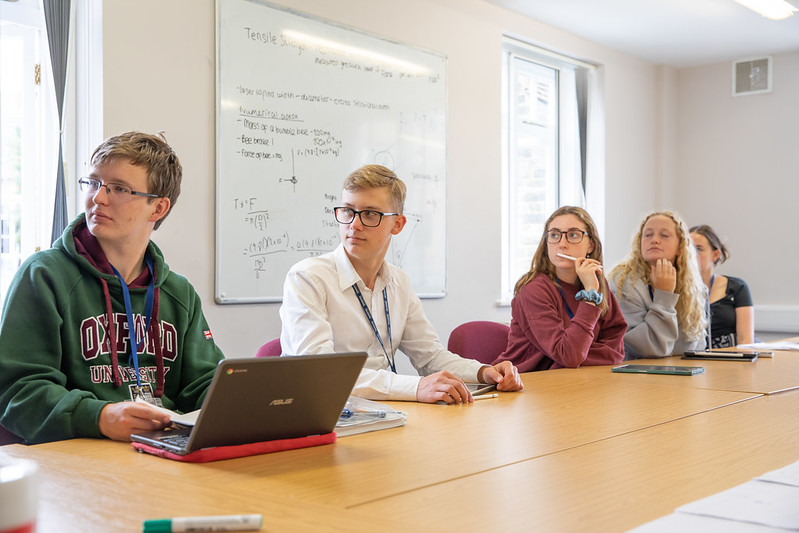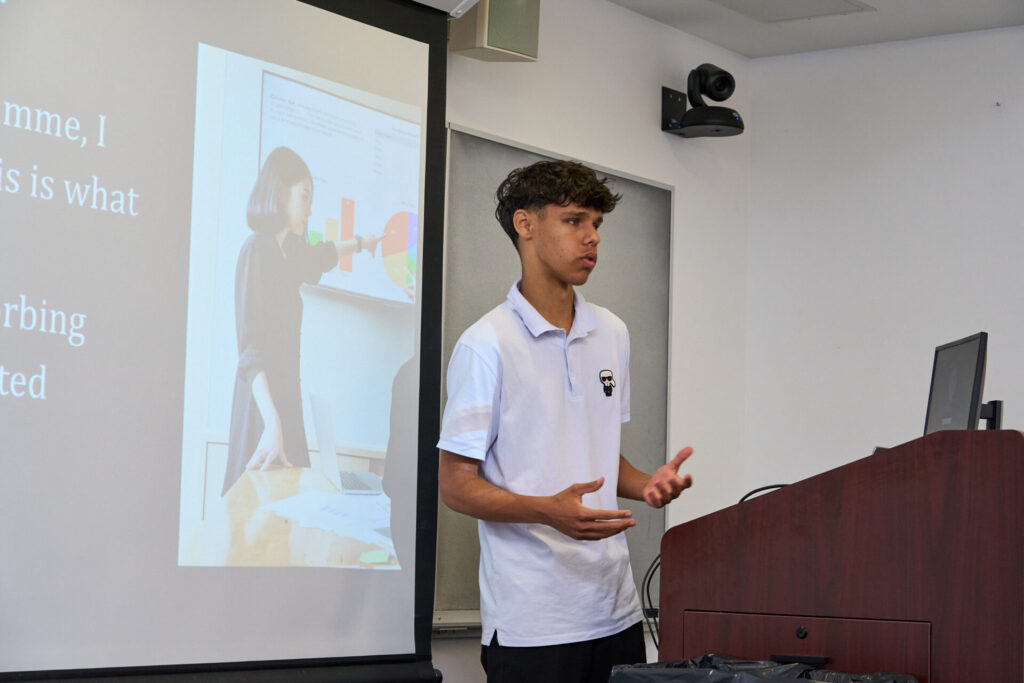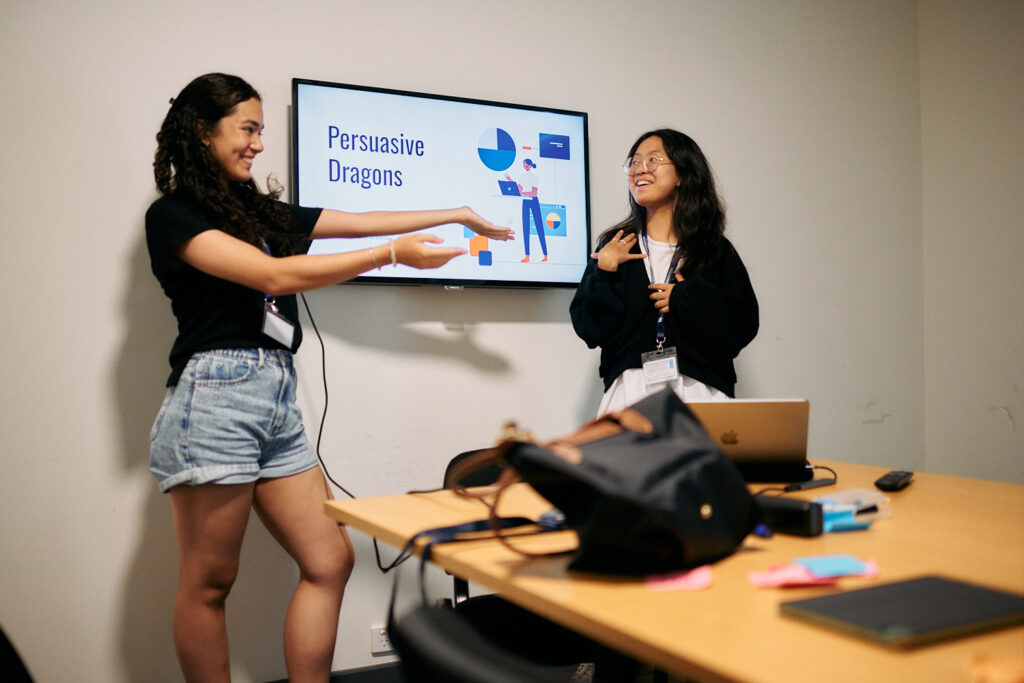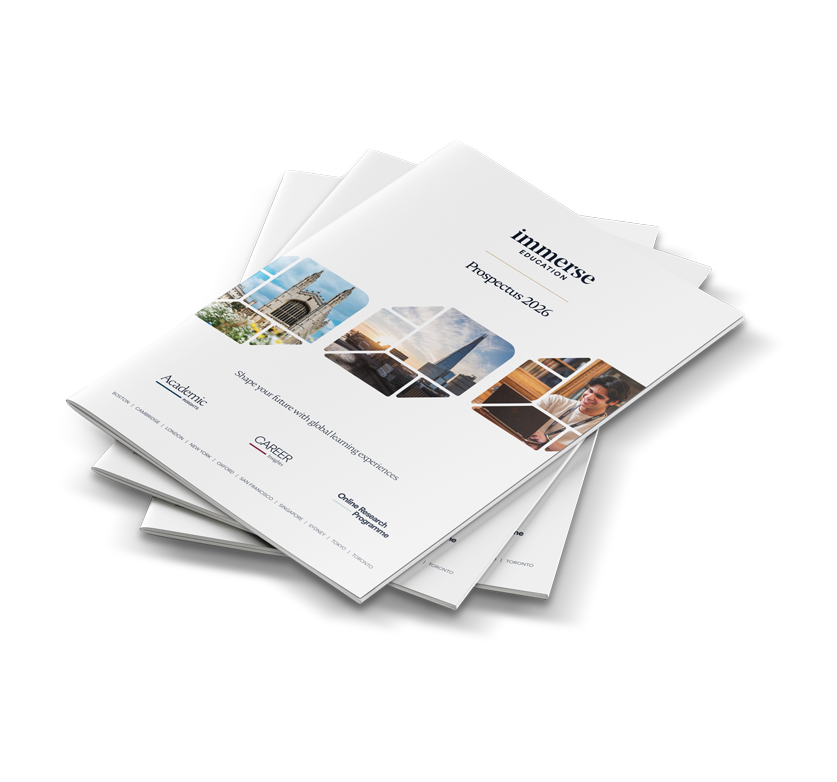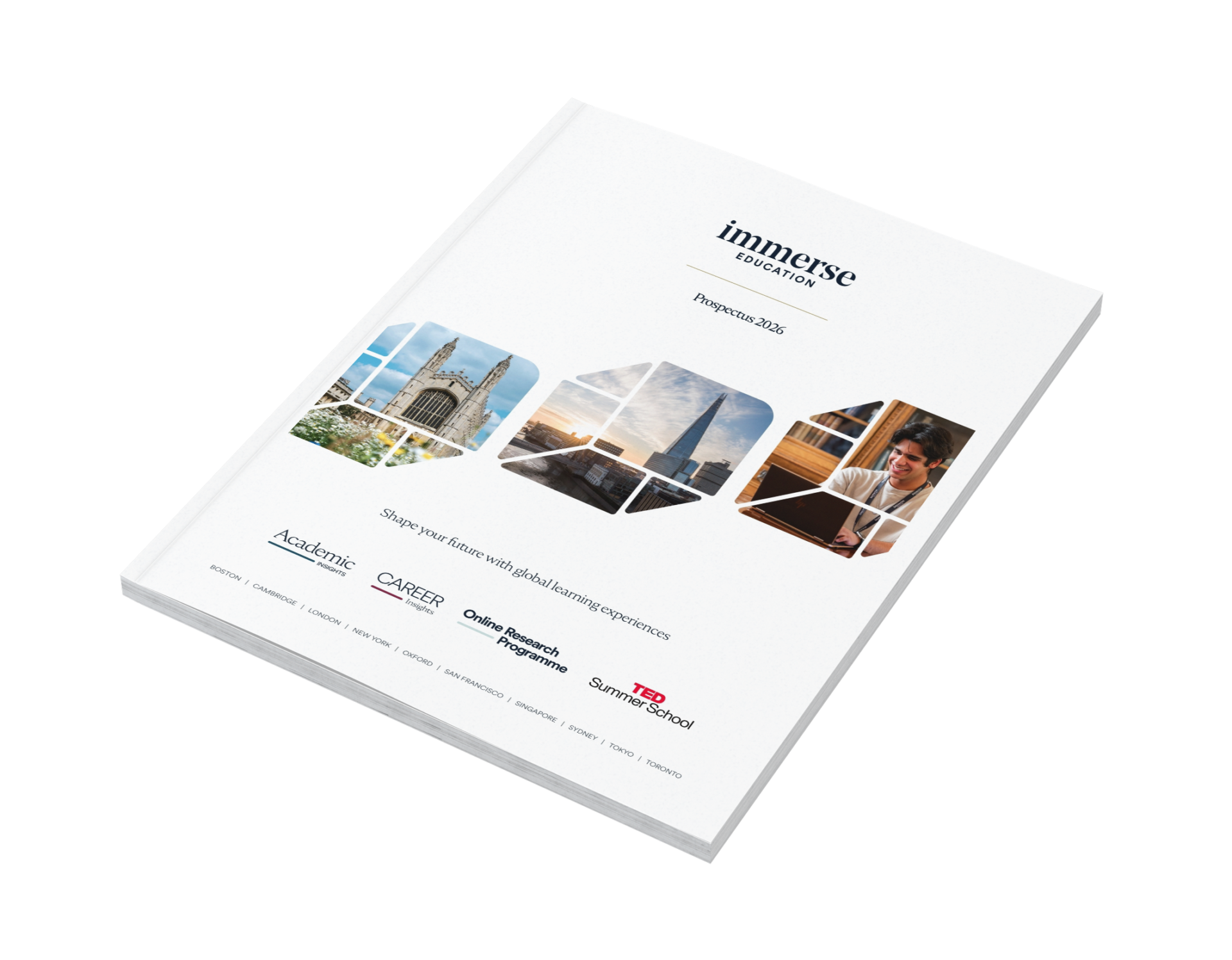Picture the spotlight warming your face, the soft hum of anticipation in the room, the quiet breath before you begin. In that moment, knowing how to improve presentation skills changes everything.
TED speakers inspire millions not just with their ideas, but with how they present them through voice, rhythm, and story that turn information into inspiration.
At Immerse’s TED Summer School, you’ll experience this transformation first-hand, discovering how to communicate with presence, purpose, and unforgettable impact.
This guide will help you master those same techniques: structure, connection, and confidence. You’ll learn how to present ideas that inspire action and imagination.
Why Good Presentation Skills Are Important
Good presentation skills are important because they help you communicate ideas clearly, build trust, and inspire action.
They turn information into connection, allowing your audience to see, feel, and remember what matters most. Strong presenters do more than share facts; they create moments that move people, whether in a classroom, boardroom, or on stage.
In today’s world, every opportunity depends on how effectively you express yourself. When you can speak with clarity and confidence, you open doors to collaboration, leadership, and influence.
Ultimately, presentation skills shape not only how others see you but how you see yourself, capable, composed, and ready to make an impact.
Benefits of Improving Presentation Skills
Improving presentation skills helps you communicate with clarity, connect with confidence, and inspire your audience to take action.
Here are five powerful benefits:
- Confidence that lasts: Regular practice replaces anxiety with assurance, helping you feel in control on any stage or in any setting.
- Communication that connects: You learn to translate complex ideas into stories people understand and remember.
- Leadership that inspires: Strong presentation skills show initiative and influence, qualities that stand out in school, interviews, and careers.
- Opportunities that grow: Effective presenters attract attention, build credibility, and open doors to scholarships, collaborations, and leadership roles.
- Connection that moves people: Presenting with emotion and authenticity builds empathy and leaves a lasting impact on your audience.
When you improve how you present, you strengthen every part of how you learn, lead, and share ideas with the world.
The Science Behind Great Presentations
Great presentations work because they align with how the human brain processes information, emotion, and memory.
Research from Stanford University found that people remember stories 22 times more than facts alone. When you use narrative, your audience’s brain releases oxytocin, a chemical linked to empathy and trust. That reaction makes your message feel personal, not just logical.
Our minds also rely on structure to stay engaged. Studies in cognitive psychology show that when information follows a clear pattern of beginning, middle, and end, the brain processes it more efficiently, improving focus and recall. This is why TED speakers and skilled communicators use simple story arcs to make complex ideas easy to follow.
In business, clarity is just as essential as creativity. As data visualisation expert Stephen Few explains, “Numbers have an important story to tell. They rely on you to give them a clear and convincing voice.” When complex information is presented without context or interpretation, it loses its power to inform and persuade.
At our Business Management Summer School, you learn how to transform data and ideas into presentations that combine logic with emotion. Through case studies and collaborative projects, you develop the ability to communicate complex business insights with confidence, clarity, and influence.
Join the Immerse Education 2025 Essay Competition
Follow the instructions to write and submit your best essay for a chance to be awarded a 100% scholarship.

How to Improve Presentation Skills
Understanding the science behind great presentations is only the first step. The next is putting those ideas into practice through preparation, focus, and self-awareness.
Here is how to improve presentation skills before you step on stage.
Before the Presentation
1. Focus on One Big Idea
Every strong presentation starts with one clear message. Trying to include too much can confuse your audience and weaken your impact.
Nancy Duarte, in her TED talk The Secret Structure of Great Talks, found that great speakers build everything around a single “big idea.” This focus keeps the message simple, memorable, and meaningful.
Define your big idea in one sentence before you plan or design anything. It gives your talk direction and helps your audience remember what matters most.
2. Understand Your Audience
Strong presenters know that every audience listens differently. What connects with business leaders might not resonate with classmates or peers.
Before you begin, think about who you are speaking to and what they care about. Great communicators tailor tone, examples, and visuals to match their listeners’ interests and level of knowledge.
TED speakers do this masterfully. They speak with empathy, using relatable language and stories that make complex ideas accessible. When you shape your talk around your audience’s needs, your message feels personal and persuasive.
3. Plan Your Story from Start to Finish
Every strong presentation tells a story. A clear beginning, middle, and end help your audience stay engaged and understand your message.
Start with an opening that captures attention, such as a question, a fact, or a short story. Build the middle by explaining your main points with evidence or examples. End with a takeaway that reinforces your key message and inspires action.
Understanding how to structure your story is key to learning how to improve presentation skills, because it helps you guide your audience through your ideas in a way that feels clear, emotional, and memorable.
When your talk follows a logical flow, your audience can easily follow your ideas and remember them.
4. Use Simple Words and Keep Your Slides Clear
Clarity makes your message memorable. Avoid complex language and choose simple words instead.
For example:
- Say “use” instead of “utilise.”
- Say “start” instead of “commence.”
- Say “try” instead of “endeavour.”
Keep slides clean and easy to read. Use short phrases, not full sentences, and add visuals like charts or images to support your points. Simple slides help your audience focus on what you say, not what they read.
5. Practise Your Timing and Pauses
Pacing can make or break a presentation. Speaking too fast can confuse your audience, while speaking too slowly can lose their attention.
Julian Treasure, in his TED talk How to Speak So That People Want to Listen, reminds us that silence is powerful because it gives weight to your words. Pauses allow your audience to reflect and give you time to gather your thoughts.
Practise your delivery several times to find a steady rhythm. Record yourself or rehearse in front of someone who can offer feedback. Good pacing makes your talk sound calm, confident, and engaging.
6. Calm Your Nerves Before You Begin
Feeling nervous before a presentation is normal. The goal is not to remove the nerves but to control them.
Amy Cuddy, in her TED talk Your Body Language May Shape Who You Are, explains that standing tall and opening your posture for just two minutes can increase confidence and reduce stress. This physical shift helps your mind feel more prepared and in control.
Take a few slow breaths before you start. Focus on your first line rather than the whole talk. Confidence builds as soon as you begin speaking.
During the Presentation
7. Stand Tall and Make Eye Contact
Your body communicates confidence before you even speak. Standing tall and maintaining eye contact helps your audience see that you believe in your message.
Keep your shoulders relaxed and your movements steady. Avoid pacing or crossing your arms, as these can distract from your words. Instead, move with purpose and look at different sections of the audience to keep everyone engaged.
Strong posture and connection through eye contact make your presentation feel calm, confident, and genuine.
8. Use Your Voice to Show Energy
Your voice brings your message to life. A steady, expressive tone keeps your audience interested and helps them understand your emotions and intent.
Vary your pitch, pace, and volume to match your message. Speak with energy when you want to inspire, and slow down when explaining something complex. Avoid speaking in a flat tone, as it can make even strong ideas sound dull.
Your voice should sound natural but purposeful. When you speak with genuine enthusiasm, people are more likely to listen and remember what you say.
Understanding vocal tone and expression is key to learning how to improve presentation skills, because your voice shapes how your audience feels, reacts, and connects to your message.
9. Involve Your Audience
Great presenters turn their talks into conversations. When you involve your audience, you build a connection and keep attention focused on your message.
TED speakers often use this technique by asking questions, inviting short reflections, or encouraging a show of hands. These moments make the audience feel part of the story rather than passive listeners.
You can do the same. Ask for opinions, relate your ideas to shared experiences, or pose a question that makes people think. Audience involvement makes your presentation feel more personal and memorable.
10. Stay Calm If You Make a Mistake
Delivering a great presentation is not about perfection but about connection and composure. Even experienced speakers make small mistakes, but they recover quickly and move on.
If you forget a point or stumble over a word, pause, take a breath, and continue confidently. Most audiences will not notice, and those who do will respect your calm response.
What matters most is how you handle the moment. Staying composed shows confidence and authenticity, reminding your audience that you are human and that your message matters more than any minor error.
11. Notice How Your Audience Reacts
Paying attention to your audience helps you adjust and stay connected. Notice their expressions, posture, and focus as you speak. If they seem distracted or confused, slow down or explain your point in a simpler way.
TED speakers often read the room carefully, using energy and tone to match their listeners’ reactions. They adapt in real time, ensuring their message feels relevant and engaging.
When you stay aware of your audience, your presentation becomes a shared experience. You guide the conversation, keeping people involved from start to finish.
12. Be Yourself on Stage
Authenticity is what makes a presentation memorable. The best speakers sound natural and speak from personal experience rather than trying to sound perfect.
Brené Brown, in her TED talk The Power of Vulnerability, shows that honesty and openness create real connection. When you let your personality show, people trust you more and listen more closely.
Share stories or examples that reflect who you are. Speak in your own voice and avoid copying someone else’s style. Being yourself helps your audience see not just what you know, but who you are — and that is what inspires them most.
At our TED Summer School, you take these presentation techniques from theory to practice. Each session helps you refine storytelling, delivery, and stage presence through interactive workshops inspired by real TED-style talks.
You learn to communicate ideas with clarity, emotion, and confidence, skills that help you speak with authenticity both on stage and beyond.
Interactive Exercise: The 30-Second Hook Challenge
Goal: Practise opening your talk with confidence, curiosity, and clarity just like a TED speaker.
How to Play:
- Pick a Topic – Anything you love or care about. It could be music, the environment, or your favourite film.
- Set a Timer – You have 30 seconds to grab your audience’s attention.
- Choose a Hook Type:
☐ Ask a surprising question
☐ Share a quick personal story
☐ Start with a bold fact or statistic
☐ Use humour (appropriately!) - Record or Perform Live – Deliver your opening line to a friend, family member, or your phone camera.
- Score Yourself:
☐ Did I make my audience curious?
☐ Did I sound confident and clear?
☐ Did I smile or show energy?
☐ Did I end on a line that made them want to hear more?
Common Presentation Mistakes and How to Avoid Them
Even skilled presenters can slip into habits that weaken their message. Recognising and correcting these mistakes can make the difference between a good talk and a memorable one.
- Overloading Information – Too much text or data overwhelms your audience. Simplify your message and present one main idea per slide or section. Use visuals or short bullet points to keep attention focused.
- Reading Directly from Notes – Reading word-for-word sounds flat and reduces connection. Know your material well enough to speak naturally. Use short prompts instead of full scripts.
- Ignoring Visuals – Slides should support, not repeat, what you say. Choose images, charts, or infographics that explain or enhance your message.
- Rushing Through Points – Speaking too quickly makes it hard for people to follow your ideas. Slow down and use pauses to emphasise key moments.
- Skipping Practice – Without rehearsal, timing and delivery suffer. Practise aloud, record yourself, or rehearse with a friend. Each run helps you refine your flow and confidence.
Building Presentation Confidence Through Immerse Programmes
Confidence grows through preparation and experience. The more you practise presenting and learning more about how to improve presentation skills, the more natural and expressive you become.
At the New York Summer School, participants aged 15–18 strengthen their communication and presentation skills while exploring one of the world’s most dynamic cities.
Lessons are interactive and hands-on, blending academic learning with real-world experiences. Students practise sharing ideas, pitching solutions, and speaking with confidence in a collaborative setting.
Based at Barnard College, Columbia University, the programme combines expert-led workshops with cultural discovery. Every activity helps you connect learning with life beyond the classroom, building confidence, self-belief, and the perspective of a future leader.
Inspire Like a TED Speaker
Learning how to improve presentation skills is about more than speaking well; it is about expressing ideas with clarity and confidence. The best presenters connect through purpose, not perfection.
At the TED Summer School, you bring these lessons to life. Through workshops and feedback, you learn to tell stories that inspire, present with presence, and communicate with genuine impact.
Remember, every great speaker starts with the same uncertainty. What sets them apart is practice, patience, and the courage to be themselves. You do not need perfection to deliver a powerful presentation; you only need the confidence to share your voice and believe it matters.











